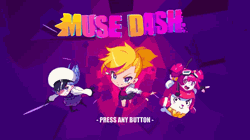 So you’ve decided to get into the wonderful world of the videogame rhythm genre. Good for you! Rhythm games are some of the best pickup and play games out there, as they traditionally feature challenges that are exactly one song’s length. No half-hour failure states to be seen in this genre! And the music! Who doesn’t love music? Nobody, that’s who! So everyone should love rhythm games, too!
So you’ve decided to get into the wonderful world of the videogame rhythm genre. Good for you! Rhythm games are some of the best pickup and play games out there, as they traditionally feature challenges that are exactly one song’s length. No half-hour failure states to be seen in this genre! And the music! Who doesn’t love music? Nobody, that’s who! So everyone should love rhythm games, too!
But, please be aware that there are three distinct kinds of rhythm games. In an effort to help a neophyte understand what has been happening in this genre that has been kicking around for 25 years, please enjoy a quick rundown of the places you’ll see.
The Artisanal Rhythm Game
There were proto-rhythm games practically as long as gaming has existed (anyone remember that bit in Back to the Future? I guess you guys aren’t ready for that yet), but many point to PaRappa the Rapper as the true origin of what we consider to be rhythm games. And it makes sense! This was one of the first games released on a CD-based system that could handle something like “real” songs (if there is a library of early PC games weeping in the corner at this statement: good), and, after a slew of games where children wearing their pants backwards demanded that you make their videos, someone had finally figured out a good way to marry music to gameplay. On a superficial level, PaRappa was just pressing prescribed buttons to a preset beat. But on a practical level? Like all artisanal rhythm games, PaRappa was an inimitable experience that left an indelible impression on anyone that dared take driving lessons with a rapping dog.
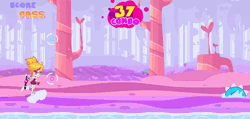 And why was PaRappa so unforgettable? Well, quite simply, because it was fun while goddamned everything about it funneled back into “make this more fun”. It was fun to press buttons to the beat. It was fun to be ranked “cool”. It was fun to meet these goofy characters. It was fun to see this unique art style in motion. The music was fun. The graphics were fun. Even seeing a game over screen, complete with PaRappa lamenting how he apparently did not believe hard enough, is fun. Absolutely everything about PaRappa fed back into one incredibly solid presentation, and, while the game was maybe not as long as those “70 hour JRPGs” that were also on the system, every moment you did play was incredible. It was not just about the songs or the lyrics or the characters, it was everything.
And why was PaRappa so unforgettable? Well, quite simply, because it was fun while goddamned everything about it funneled back into “make this more fun”. It was fun to press buttons to the beat. It was fun to be ranked “cool”. It was fun to meet these goofy characters. It was fun to see this unique art style in motion. The music was fun. The graphics were fun. Even seeing a game over screen, complete with PaRappa lamenting how he apparently did not believe hard enough, is fun. Absolutely everything about PaRappa fed back into one incredibly solid presentation, and, while the game was maybe not as long as those “70 hour JRPGs” that were also on the system, every moment you did play was incredible. It was not just about the songs or the lyrics or the characters, it was everything.
PaRappa the Rapper itself had a handful of sequels, and there were a few other games outside of PaRappa’s universe that tried for something similar. Gitaroo-Man immediately springs to mind as one of the luminaries of this era of rhythm games, but there was also the likes of Mad Maestro and Vib-Ribbon. All of these titles were unique not in just their subjects and presentations, but also in that they generally had wildly different ways to interpret “rhythm” as more than merely “press X when I say so”. Um Jammer Lammy and Gitaroo-Man both strummed their guitars in very different ways. And, give or take the classics of Mad Maestro, all of these games had wholly unique soundtracks that had to be good songs and good levels.
Unfortunately, it seems that this kind of presentation was not sustainable. Even at the height of the artisanal rhythm game age, there were only a few Space Channels to tune into. Entirely “artisanal” titles basically required that the games last about as long as your average album (or maybe a 2-disc greatest hits CD set), and, amazing presentation or no, people wanted more content. Pouring piles of resources into a 40 minute experience was never going to be viable, and the only reason we have a modern descendant of this age of rhythm games is that apparently Hatsune Miku is more prodigious than we ever could have imagined. If you want a Gitaroo-esque experience, you basically need to sign on with a Vocaloid. Otherwise, you are probably playing with the rhythm genre that ate artisanal’s lunch…
The Song-based Rhythm Game
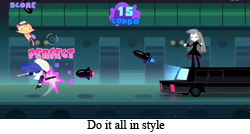 This one makes sense, right? You play rhythm games for the music, so why not base the entire game around the music. Drop any unnecessary graphics, give up on even the illusion of a story, make all the characters generic avatars, and pour your entire budget into licensing rights. Maybe invest an extra six bucks in some hunk of plastic vaguely shaped like a musical instrument, and, bingo bongo, you’ve got an award-winning genre. Guitar Hero killed the Gitaroo-Man.
This one makes sense, right? You play rhythm games for the music, so why not base the entire game around the music. Drop any unnecessary graphics, give up on even the illusion of a story, make all the characters generic avatars, and pour your entire budget into licensing rights. Maybe invest an extra six bucks in some hunk of plastic vaguely shaped like a musical instrument, and, bingo bongo, you’ve got an award-winning genre. Guitar Hero killed the Gitaroo-Man.
And that may not have been a bad thing.
If we acknowledge that artisanal rhythm titles were unsustainable, then perhaps we should admit that the likes of Guitar Hero, Rock Band, or even Dance Dance Revolution could be an infinite source of games. There is new music being produced every second of every day, and it would not be impossible to adapt every week’s Top 40 to a Rock Band chart. And, looking at a few digital storefronts, I am pretty sure the Rock Band DLC model tried that! And why wouldn’t they? When divorced from the burden of things like varied presentation or any semblance of a plot, you can just sync up your game to the radio and call it a day. Nobody is ever going to complain about more Beatles songs!
And while it may sound harsh to repeatedly insult an entire genre because nobody wanted to dress a teenager up in a winged helmet anymore, let us be clear on one thing: these rhythm games are just as fun as their more intricate forbearers. There is a reason the Guitar Hero controller became a staple of households in the early 21st Century, and you will pry my Taiko: Drum Master drum from my cold, calloused drummin’ hands. Some attempts within this genre did not work particularly well (hello again, DJ Hero), but whether you were rolling out a dance mat or an entire multipiece rock band, the rhythm games that existed to support their song libraries were universally fun. And modern releases in this genre (Taiko drumming is back, baby) remind us that we do not need ridiculous peripherals to have fun. Of course, Just Dance 20XX already knew that…
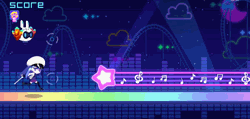 But, as Rock Band gradually faded into memory (and Dance Dance Revolution barely made it out of the 90s), a simple question was posed: could rhythm games get back to being games? Sure, we have all seen people use a DDR mat to beat Final Fantasy 7, but could there be games designed to be videogames and rhythm games? Not quite the rhythm experiences of the artisanal titles, and something that could include a playlist like your typical Guitar Hero? Well…
But, as Rock Band gradually faded into memory (and Dance Dance Revolution barely made it out of the 90s), a simple question was posed: could rhythm games get back to being games? Sure, we have all seen people use a DDR mat to beat Final Fantasy 7, but could there be games designed to be videogames and rhythm games? Not quite the rhythm experiences of the artisanal titles, and something that could include a playlist like your typical Guitar Hero? Well…
The Rhythm Game Games
What makes a videogame a videogame? Why is digital solitaire considered some kind of empty diversion, while Triple Triad is lauded as the second coming of Cyber Jesus? How is Tetris the most important videogame of all time, while Candy Crush is exploitative dreck? Because nerds are snobs we have certain expectations about what makes a videogame a videogame. If you want to differentiate Lord of the Rings cosplay from a formal Final Fantasy game, you need a few of those trappings that always work as bullet points on the back of a box. Leveling system? Item management? Crafting? Gimme something, potential videogame, otherwise you will have to wallow in the Minesweeper pit.
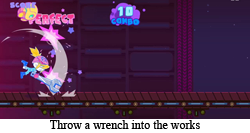 Despite ranking and scores, there is a lot about the Song-based Rhythm Games Collection that does not feel like a videogame. It is just pressing buttons to a rhythm! You could annoy the rest of the freeway and just do that with your FM radio and a car horn! Similarly, while the Artisanal Rhythm Game may have all the progress and “numbers go up” you would expect from seeing Cloud venture forth to murder the guy with the best hair on the planet, the natural limits of the presentation preclude unlimited song variety. If only there were a way to keep a rhythm game visually interesting, include a variety of “systems” to keep the gamers happy, but still keep it simple enough to slot in an entire Top 40 worth of content. And it wouldn’t hurt if there were unlockables for days, too…
Despite ranking and scores, there is a lot about the Song-based Rhythm Games Collection that does not feel like a videogame. It is just pressing buttons to a rhythm! You could annoy the rest of the freeway and just do that with your FM radio and a car horn! Similarly, while the Artisanal Rhythm Game may have all the progress and “numbers go up” you would expect from seeing Cloud venture forth to murder the guy with the best hair on the planet, the natural limits of the presentation preclude unlimited song variety. If only there were a way to keep a rhythm game visually interesting, include a variety of “systems” to keep the gamers happy, but still keep it simple enough to slot in an entire Top 40 worth of content. And it wouldn’t hurt if there were unlockables for days, too…
The Rhythm Game Games scratch the rhythm and game itches equally. On one hand, you have a game that is simple enough to support an initial pile of songs, and then include DLC tunes that will last until the workers stop building them new ones. On the other hand, you have all sorts of interesting “systems” included, and many of these systems allow you to unlock new songs, styles, and playable characters. Can you do such in other games? Of course! But in a Rhythm Game Game, it actually matters.
Take the title that inspired today’s article: Muse Dash. Muse Dash touts “97 initial popular songs” and “continuous free updates” as of its 2019 launch. Playing this title two years later, I am pretty sure I have discovered it currently includes 9,409 songs… though my math may be a tweak off. It takes a while to scroll through the song menus! And the sheer variety of songs available is important, because you are going to want to play through a lot of songs as Muse Dash allows your “player profile to level up”, and earn a lot of bits and baubles along with every level up. Want to earn all the playable characters? The “playable” assistants? Loading screen images? Marginally animated title screens? Well then you better get to playing through some of those 88,000,000 songs, because you have a lot of trophies to earn!
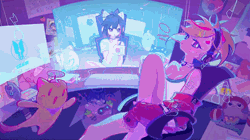 Actually, referring to all the collectibles in Muse Dash as “trophies” is wildly reductive. Star high school quarterbacks and gamers alike all eventually learn the same truth: trophies are useless. But in Muse Dash, you earn actual gameplay elements. There are multiple characters to unlock (well, technically, there are only three characters, but they have multiple costumes that apparently change said character’s personalities, so same diff), but, more important than the cosmetic changes, every character allows for a different play “style”. One choice allows “excellent” ratings to be more easily attainable, while another continues the combo count regardless of an errant button press. One option even transforms the game into a vertical mode! In much the same way that playing as different characters in a fighting game radically changes the experience, the possibilities in Muse Dash similarly change the game. And that is before we get to the “helper” characters that not only offer different possibilities individually, but may combine with the playable characters in strange, unique, or just plain profitable ways. Think of all the different ways you can combine these choices into a game that is wholly customized for you!
Actually, referring to all the collectibles in Muse Dash as “trophies” is wildly reductive. Star high school quarterbacks and gamers alike all eventually learn the same truth: trophies are useless. But in Muse Dash, you earn actual gameplay elements. There are multiple characters to unlock (well, technically, there are only three characters, but they have multiple costumes that apparently change said character’s personalities, so same diff), but, more important than the cosmetic changes, every character allows for a different play “style”. One choice allows “excellent” ratings to be more easily attainable, while another continues the combo count regardless of an errant button press. One option even transforms the game into a vertical mode! In much the same way that playing as different characters in a fighting game radically changes the experience, the possibilities in Muse Dash similarly change the game. And that is before we get to the “helper” characters that not only offer different possibilities individually, but may combine with the playable characters in strange, unique, or just plain profitable ways. Think of all the different ways you can combine these choices into a game that is wholly customized for you!
Why, it is almost like there is an entire game in these menus before you play the rhythm game proper. It is a Rhythm Game Game.
This is, of course, nothing new in gaming. The idea that you spend more time outside of battles fiddling in menus in Pokémon or Final Fantasy alike is something that was established well before the turn of the millennium. And, in fact, simulating that “menu play” from Final Fantasy may have accidentally birthed this whole genre in Final Fantasy Theatrhythm. This is all nothing new to gaming at large, but it is new to the rhythm genre that has never really found the same kind of foothold as beat ‘em ups, fighting games, or even rogue-likes. Thanks to games like Muse Dash, people who “like videogames” can like rhythm games!
Or… uh… it looks like the company that made Muse Dash filed for bankruptcy in April?
Looking forward to updating this article with the next, next generation of rhythm games!
FGC #592 Muse Dash
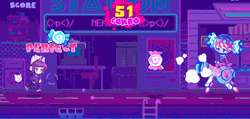 System: Nintendo Switch is where I played it, and this apparently also has a following on mobile devices. … But playing without buttons is not for me. Warioware can go touch itself.
System: Nintendo Switch is where I played it, and this apparently also has a following on mobile devices. … But playing without buttons is not for me. Warioware can go touch itself.- Number of players: You could see how split screen could work for this without much effort, but this is definitely one player.
- Sexual Dimorphism is a Scourge: There does not seem to be a single named male character in this entire game. That’s good! And the first item on the PeroPeroGames webstore is a statue of the Muse Dash heroine in bunny lingerie. That’s bad! The background noise of Muse Dash seems to split its attention between “bubblegum cute” and “these characters are sexy and bouncing” amongst its various menus, but the actual gameplay and general tone leans closer to “cute”.
- Favorite Song: I would very much like to tell you my favorite song, but… I lost it. There was one in there I really liked! And I should have marked it as a favorite, as now it is lost in the hundreds-strong playlist of Muse Dash. The dangers of always adhering to that “random” button…
- Favorite Stage: If I have one major complaint about Muse Dash, it’s that it contains a whole seven stages for its billion songs, and of those, approximately 80% seem to utilize the boring “Space Station” area (which looks more like a construction site). That said, the Castle area, filled with ghosts, skeletons, and a succubus, should be the dominant level. Those goofy vampires look so happy!
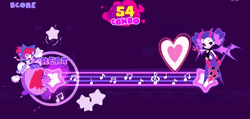 Did you know? This game recommends you wear wired headphones on every boot. I have not worn headphones with a gaming system since… the Sega Genesis. What? I usually play in a room by myself! I like a warm sound in the room… Or to be listening to something else.
Did you know? This game recommends you wear wired headphones on every boot. I have not worn headphones with a gaming system since… the Sega Genesis. What? I usually play in a room by myself! I like a warm sound in the room… Or to be listening to something else.- Would I play again: This is a fun game to have loaded on my Switch forever. I could see playing a song here or there when I have a few moments between more dedicated playing experiences. … Or when I’m waiting for Smash Bros. to download an update… Whatever! This is a fun gamey game, and I can continue to earn bibs and baubles while playing great songs anytime.
What’s next? Random ROB has chosen… Castlevania II: Simon’s Quest! It’s time to see if we can reassemble even a single Dracula! Please look forward to it!
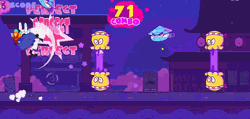
Sometimes things can get hectic